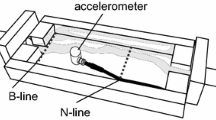Summary
The tremble dance is a behavior sometimes performed by honeybee foragers returning to the hive. The biological significance of this behavior was unclear until Seeley (1992) demonstrated that tremble dances occur mainly when a colony's nectar influx is so high that the foragers must undertake lenghty searches in order to find food storers to unload their nectar. He suggested that tremble dancing has the effect of stimulating additional bees to function as food-storers, thereby raising the colony's capacity for processing nectar. Here I describe vibrational signals emitted by the tremble dancers. Simulation experiments with artificial tremble dance sounds revealed that these sounds inhibited dancing and reduced recruitment to feeding sites. The results suggest that the tremble dance is a negative feedback system counterbalancing the positive feedback of recruitment by waggle dances. Thus, the tremble dance seems to affect not only the colony's nectar processing rate, but also its nectar intake rate.
Similar content being viewed by others
References
Dreller C, Kirchner WH (in press a) Hearing in honeybees: localization of the auditory sense organ. J Comp Physiol A
Dreller C, Kirchner WH (in press b) How honeybees perceive the information of the dance language. Naturwissenschaften 80:
Esch H (1964) Beiträge zum Problem der Entfernungsmessung in den Schwänzeltänzen der Honigbiene. Z Vergl Physiol 48:534–546
Frisch K von (1923) Über die Sprache der Bienen — eine tierpsychologische Untersuchung. Zool JB Physiol 40:1–186
Frisch K von (1967) The dance language and orientation of bees. Harvard University Press, Cambridge
Kirchner WH (in press) Acoustical communication in honeybees Apidologie
Kirchner WH, Sommer K (1992) The dance language of the honeybee mutant diminutive wings. Behav Ecol Sociobiol 30:181–184
Kirchner WH, Lindauer M, Michelsen A (1988) Honeybee dance communication — acoustical indication of direction in round dances. Naturwissenschaften 75:629–630
Kirchner WH, Dreller C, Towne WF (1991) Hearing in honeybees: operant conditioning and spontaneous reactions to airborne sound. J Comp Physiol A 168:85–89
Lindauer M (1948) Über die Einwirkung von Duft- und Geschmacksstoffen Bowie anderer Faktoren auf die Tänze der Bienen. Z Vergl Physiol 31:348–412
Michelsen A, Kirchner WH,0 Andersen BB, Lindauer M (1986a) The tooting and quacking vibration signals of honeybee queens: a quantitative analysis. J Comp Physiol A 158:605–611
Michelsen A, Kirchner WH, Lindauer M (1986b) Sound and vibrational signals in the dance language of the honeybee, Apis mellifera. Behav Ecol Sociobiol 18:207–212
Michelsen A, Towne WF, Kirchner WH, Kryger P (1987) The acoustic near field of a dancing honeybee. J Comp Physiol A 161:633–643
Michelsen A, Andersen BB, Storm J, Kirchner WH, Lindauer M (1992) How honeybees perceive communication dances, studied by means of a mechanical model. Behav Ecol Sociobiol 30:143–150
Nieh JC (1993) The stop signal of honey bees: reconsidering its message. Behav Ecol Sociobiol 33:51–56
Schneider F (1949) Über die Vergiftung der Bienen mit Dinitrokresol. Mitt Schweiz Entomol Ges 22:293–308
Schick W (1953) Über die Wirkung von Giftstoffen auf die Tanze der Bienen. Z Vergl Physiol 35:105–128
Seeley TD (1992) The tremble dance of the honey bee: message and meanings. Behav Ecol Sociobiol 31:375–383
Seeley TD, Towne WF (1992) Tactics of dance choice in honey bees: do foragers compare dances? Behav Ecol Sociobiol 30:50–69
Seeley TD, Camazine S, Sneyd J (1990) Collective decision-making in honey bees: how colonies choose among nectar sources. Behav Ecol Sociobiol 28:277–290
Towne WF, Kirchner WH (1989) Hearing in honeybees: detection of air-particle oscillations. Science 244:686–688
Author information
Authors and Affiliations
Rights and permissions
About this article
Cite this article
Kirchner, W.H. Vibrational signals in the tremble dance of the honeybee, Apis mellifera . Behav Ecol Sociobiol 33, 169–172 (1993). https://doi.org/10.1007/BF00216597
Received:
Accepted:
Issue Date:
DOI: https://doi.org/10.1007/BF00216597




